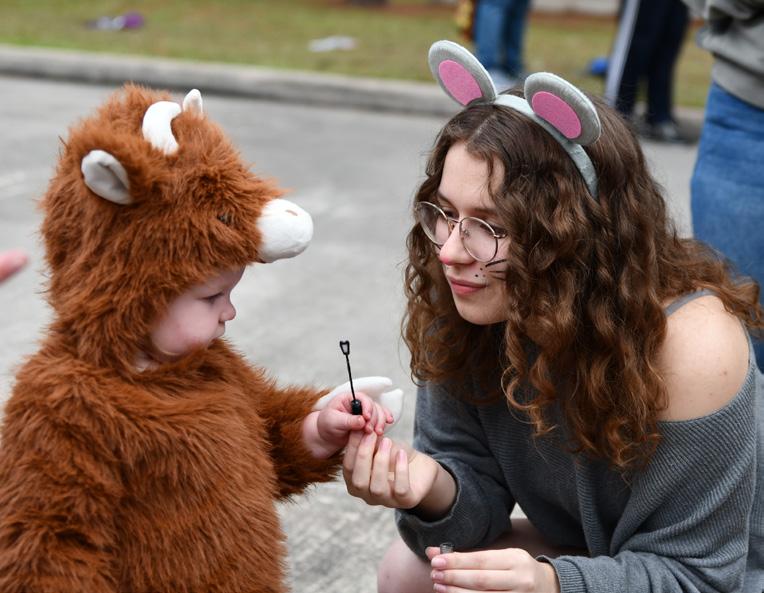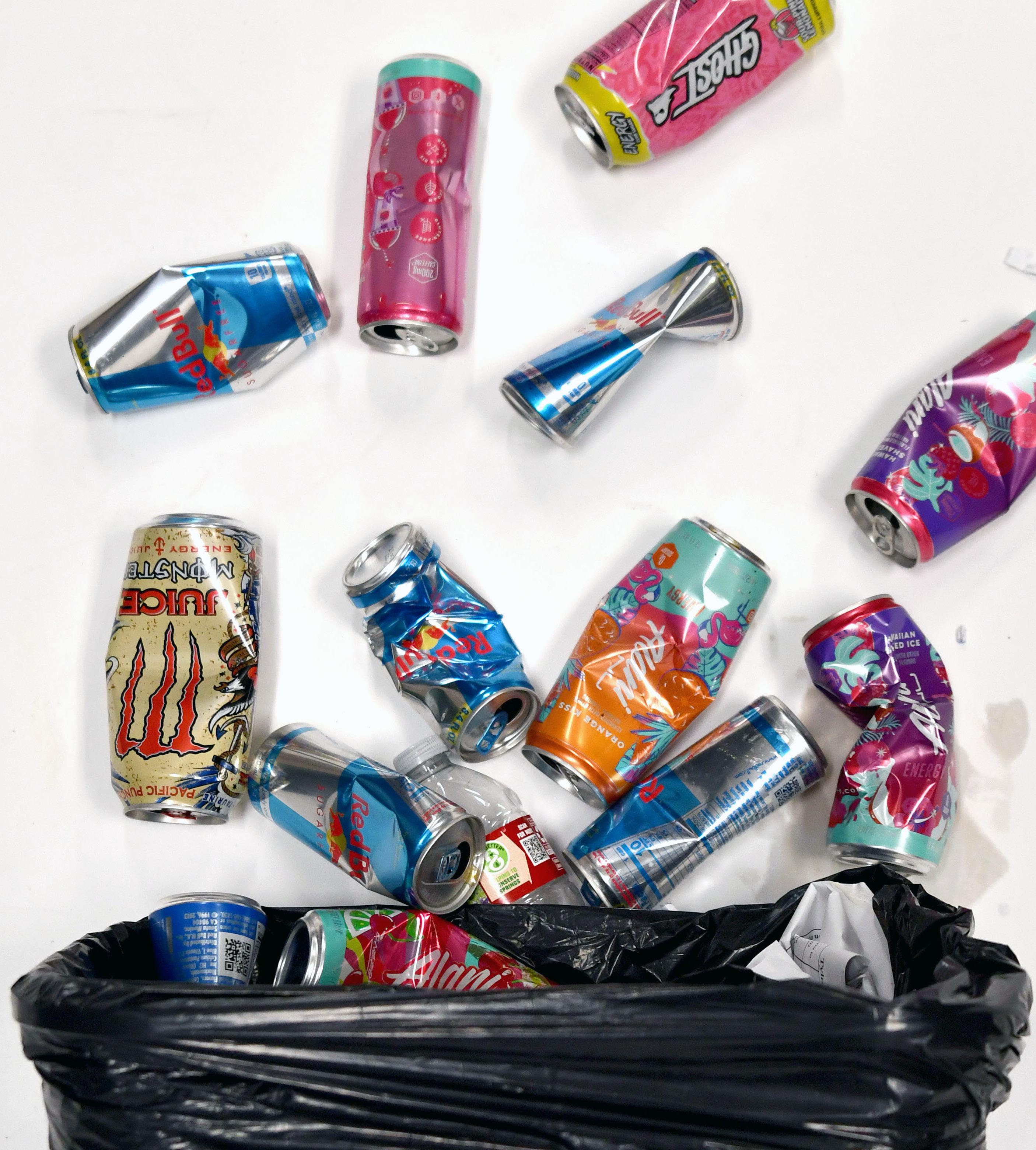








By Caleb Kazeem Staff Writer
The Tiny Homes Project started in 2017 after former assistant principal of Summer Creek Allen Segura saw a Facebook post on tiny homes in Kansas City. He contacted architecture teacher Missi Taylor, who used to work at Summer Creek, to see if she was interested. She immediately said yes.
Taylor took a trip with students to Community First, a village in Austin. She wanted to remodel the program there with one goal in mind: Build a house each year for a homeless veteran.
Because students are building a house for a veteran, Taylor wants to make sure students understand that craftsmanship and neatness matters. Although material is paid for by another organization, Taylor makes sure students still know they have to pay attention and work hard on what they are doing.
“They think it’s OK to mess up and just grab another piece of wood because they think it’s free,” Taylor said. “I always say, ‘Would you want to live in a house that is built poorly?’”

cut,” Whittington said. “Making sure that we don’t get ahead of ourselves and don’t try to rush things.”
Over time, challenges have arisen while building the homes. From first-year struggles in 2018 to the COVID years, Taylor has learned how to overcome issues to meet the goal of building one tiny home a year.
“With the first one, it was just so hard,” Taylor said. “I’d never done it. But once I’m given a deadline, I always meet them.”
Last year, senior construction manager Austin Whittington and the team dealt with struggles that set them back a few weeks. But he expects these problems can and will be avoided this year.
“We have to make sure we measure multiple times before we
The Tiny Homes team regularly travels to Langetree Retreat and Eco Center in Liberty to work on maintenance at the site where all the houses are placed.
The team is currently working on its ninth home as a whole new group of kids become involved. With all the hardships that Taylor and the students face in the program, she spends many hours on Tiny Homes and it is something very important to her.
After working with former captains Chase Bennett and Major Dalby, senior Ronan Flaherty was selected as a captain and plans to go to Texas A&M. He believes the Tiny Homes program is something

very important and should be taken seriously.
“We’re building a home for a homeless veteran, somebody who’s served our country before,” Flaherty said. “You realize the
good deed that you’ve done and I like seeing the veteran get to actually see their home that they’re going to be living in for the foreseeable future.”
By Shawn Chaney and Eleanor Durand Staff Writers
When freshman Natalia Jimenez’s parents found out she had earned the title of principal cellist, they were not only excited and teary-eyed for her but also confused.
“My dad was proud of me, but he followed his excitement with, ‘What’s that?’” Jimenez said. “But my mom had visible tears in her eyes. She was so happy.”
Twenty orchestra students participated in the Region 33 Orchestra auditions on Sept. 27. Jimenez was one of nine who advanced.
“Region is, essentially, all-stars for orchestra,” orchestra director Evan Farmer said.
The “principal” title means the student is the section leader and acts as the messenger between the conductor and the other players. They communicate with the other musicians by playing more demonstratively and with their bodies to signal when to begin playing.
Region, to a lot of players, is extremely stressful and takes up a lot of time. The stress lingers while they’re practicing because of the fear of messing up the actual audition.
“The most stressful part is wondering if you’ll mess up or not, because you only get one shot at it,” said Jimenez, a member of the school’s varsity chamber orchestra. “The best part is getting it over with and not having to practice the etudes anymore. Region is a lot of fun, and if you make it, you get to learn a lot of new things and meet new people.”
For the region competition, students were given two pieces of music to learn over the summer. On the day of the competition, the judges pick a small section for the musicians to demonstrate.
Junior violist Claire Slaydon was also named principal violist.
“It’s really hard to prepare the

1st Violin
Eden Rotberg, 10 2nd Violin
Brock Hirschfield, 11
Iana Rodrigues, 9 Viola (principal) Claire Slaydon, 11
1st Violin
Melanie Fixmer, 11 Viola
Piper Christiansen, 10 Cello
Andrea Hernandez, 12 (principal) Natalia Jimenez, 9 Bass
Amerie West, 11
song that they’re only gonna pick a little bit of because you never know what part they’re going to pick,” Slaydon said. “They usually pick two songs, one really fast and one really slow. They usually pick half a page for violas.”
For the Region 33 auditions, Slaydon brought bananas for herself and other orchestra players to eat before playing in front of the judges. She did this because the potassium in bananas can help reduce stress, and she wanted to be of help.
The person who helped Slaydon
the most was Farmer.
“Mr. Farmer has had the biggest impact on me,” Slaydon said. “I kept crying in a practice room because I was so nervous, and he told me to go play out in the room for everybody. Him forcing me to play with other people helped me gain more confidence.”
Orchestra director Evan Farmer was proud of his students who were able to do well enough to impress the judges, but there were fewer of them who did so than he had hoped for. His goal each year is for at least 10 to make region.
Some students in orchestra rely on private tutors to help them prepare for Region when they don’t feel that practicing by themselves is enough. However, not everybody can afford a private tutor, which makes it even harder for those playing the violin and bass, who seemingly had more challenging pieces to play.
“I think the etudes for the violins and basses were extremely difficult, and we were at a disadvantage because most of our students do not get private lessons,” Farmer said. “Private lessons are a huge aid in making Region, especially this year.”
in the Houston-area
Toyota Center
1510 Polk St, Houston
Upcoming Highlights
Nov. 20 - Playboy Carti: The Antagonist Tour
Nov. 22 - Burna Boy
Dec. 7 - Brandy & Monica
Dec. 31 - Treaty Oak Revival
May 5 - Florence and the Machine
May 25 - Demi Lovato
House of Blues
1204 Caroline St, Houston
Upcoming Highlights
Nov. 16 - Hot Mulligan
Nov. 28 - George Clinton & Parliament/Funkadelic
White Oak Music Hall
2915 N Main St, Houston
Upcoming Highlights
Nov. 16 - ASTN
Nov. 21 - Waylon Wyatt
Cynthia Woods
Mitchell Pavilion
2005 Lake Robbins Dr. The Woodlands
Upcoming Highlights
May 23 - Machine Gun Kelly: Lost Americana Tour with Wiz Khalifa and Beauty School Dropout
Smart Financial Centre
18111 Lexington Boulevard, Sugar Land
Upcoming Highlights
Nov. 20 - Mora
Nov. 29 - Katseye
713 Music Hall
401 Franklin St, Houston
Upcoming Highlights
Nov. 28-29 - Erykah Badu
Mama’s Gun ‘25: The Return of Automatic Slim Tour
Dec. 10 - Gunna
Feb. 6-7 - Ty Myers
NRG Stadium
1 NRG Parkway, Houston
Upcoming Highlights
March 2-21 - Houston Livestock
Show and Rodeo concert lineup will be revealed on Jan. 8.
March 22 - Cody Johnson
By Tricia Darcy Editor-in-Chief
When sophomore
Molly McCall
traveled to MetLife Stadium to see The Weeknd and Playboy Carti this summer, the familiar beat and recognizable songs reminded her of car rides with her dad.
“In the car, [my dad] put me on to rap a lot,” McCall said. “So I grew up listening to Eminem, Dr. Dre, Snoop Dogg, people like that. And he gets free NRG tickets, so we just get to go to any of those concerts for free. Getting to go with him is fun.”
McCall has been to more than 10 concerts this year alone and has plans for more in the next couple of months – a bonus of living in the fourth largest city in the U.S.
There are over 30 concert venues within an hour of Houston, ranging from a capacity of 100 people to 18,000 people at the Toyota Center. Other venues such as NRG Stadium, House of Blues, Cynthia Woods Mitchell Pavilion and White Oak Music Hall have become a weekend staple in many people’s lives.
While large venues are popular among big artists, students have found that small and mid-sized venues, like The House of Blues and 713 Music Hall, create the “concert culture” that fuels the experience, especially in big cities like Houston.
“You have more opportunities to meet the people, especially if they’re smaller and they’re newer,” senior Martha Vasquez said. “I definitely like that I have
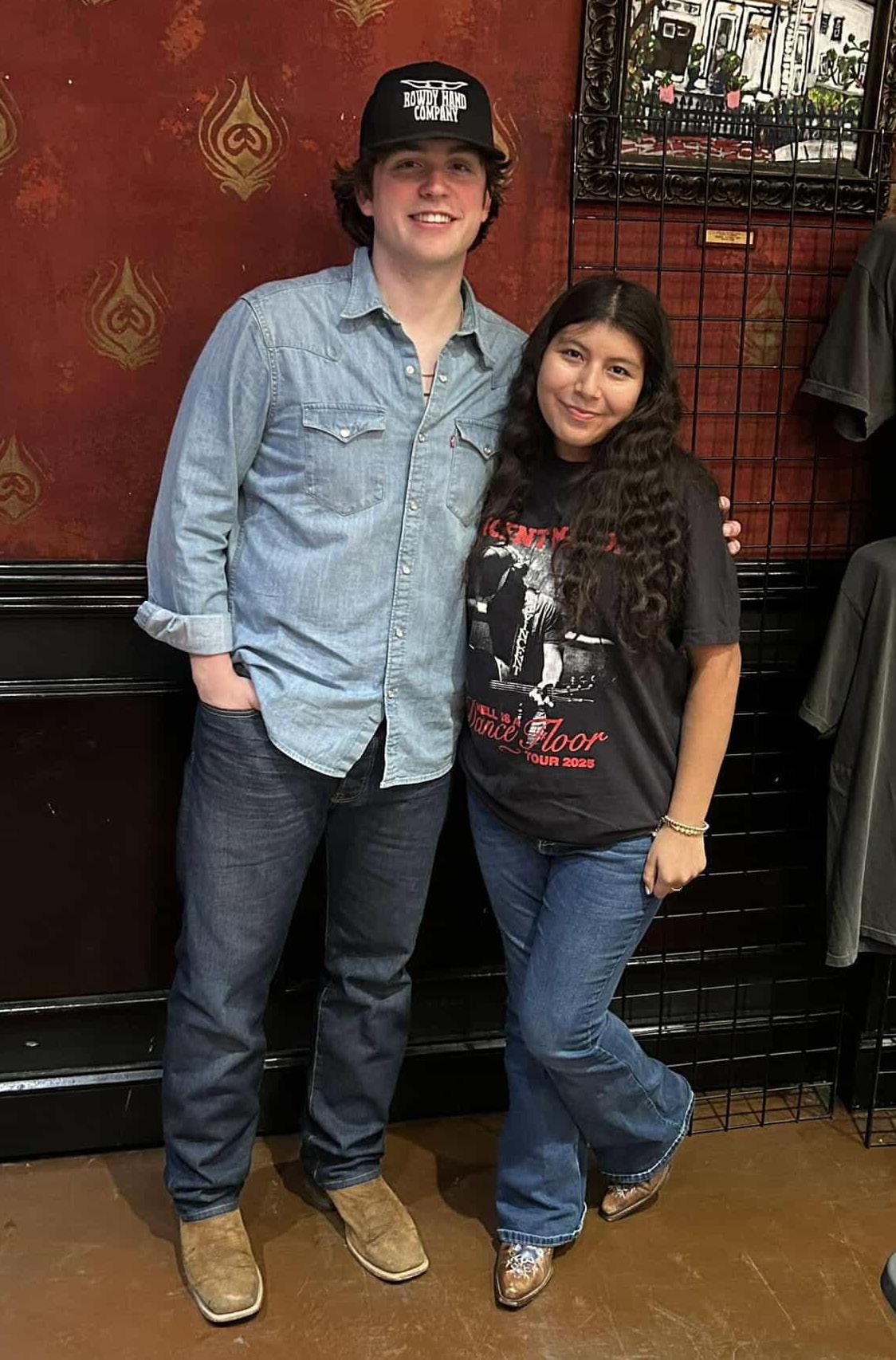
the opportunity to meet them.”
Being at the smaller venue paid off for Vasquez. When she went to the Crosby Rodeo in June, Vasquez met Ty Myers, as well as Myers’ dad, his best friend and his guitarist Reid Parker.
Other than seeing Myers, Vasquez has been to five concerts this year, most of which were country artists.
Similar to the Crosby Rodeo, Vasquez found that the smaller atmosphere at House of Blues, located in downtown Houston, was one of her favorites in the area.
“[The House of Blues is] not too small, not too big, and it gets very spacious
pretty fast,” Vasquez said. “I really like that there’s not a lot of people sometimes.”
The House of Blues has a capacity of 1,750 people and is highly ranked among live music venues in Houston because of the variety in music genres and artists that perform. Genres found at the venue range from hip hop and rap to country and alternative.
Although Houston offers a variety of genres, some popular genres have limited shows. Junior Maverick Clark said finding concerts that pertain to his musical interests has been a struggle.
“[Oakwood] was really fun though,” Clark said. “A
lot of people were jumping off of the stage and there was a mosh pit.”
Clark saw Oakwood, an emo band based in Austin, when the band performed at White Oak Music Hall in June. However, Clark’s concert experience and interest has been heavily influenced by his sister’s interest.
“I would say my sister got me into going to concerts,” Clark said. “She goes to a lot of concerts and so I kind of just tag along with her and she knows the kind of spots where they have them.”
The variety of venues in Houston allows for an easier outlet for students to have their own memorable concert experience. McCall also said she is lucky to live near a city with so many venues.
Later this month, McCall plans to see the Antagonist Tour, with Playboy Carti headlining and featured artists, Ken Carson and Destroy Lonely at Toyota Center. The opportunities to see her favorite artists at different venues has been what has made McCall’s concert experience memorable, she said.
“Since Houston’s so big I can just go anywhere,” McCall said. “You can either be at Toyota Center, NRG, Cynthia Woods Pavilion, 713 [Music Hall], Bayou [Music Center]. There’s just so many different places. It’s definitely helped because instead of having to drive five hours for each concert, it’s more accessible. Even if [the concert is] on a weekday, it’s only like an hour drive.”
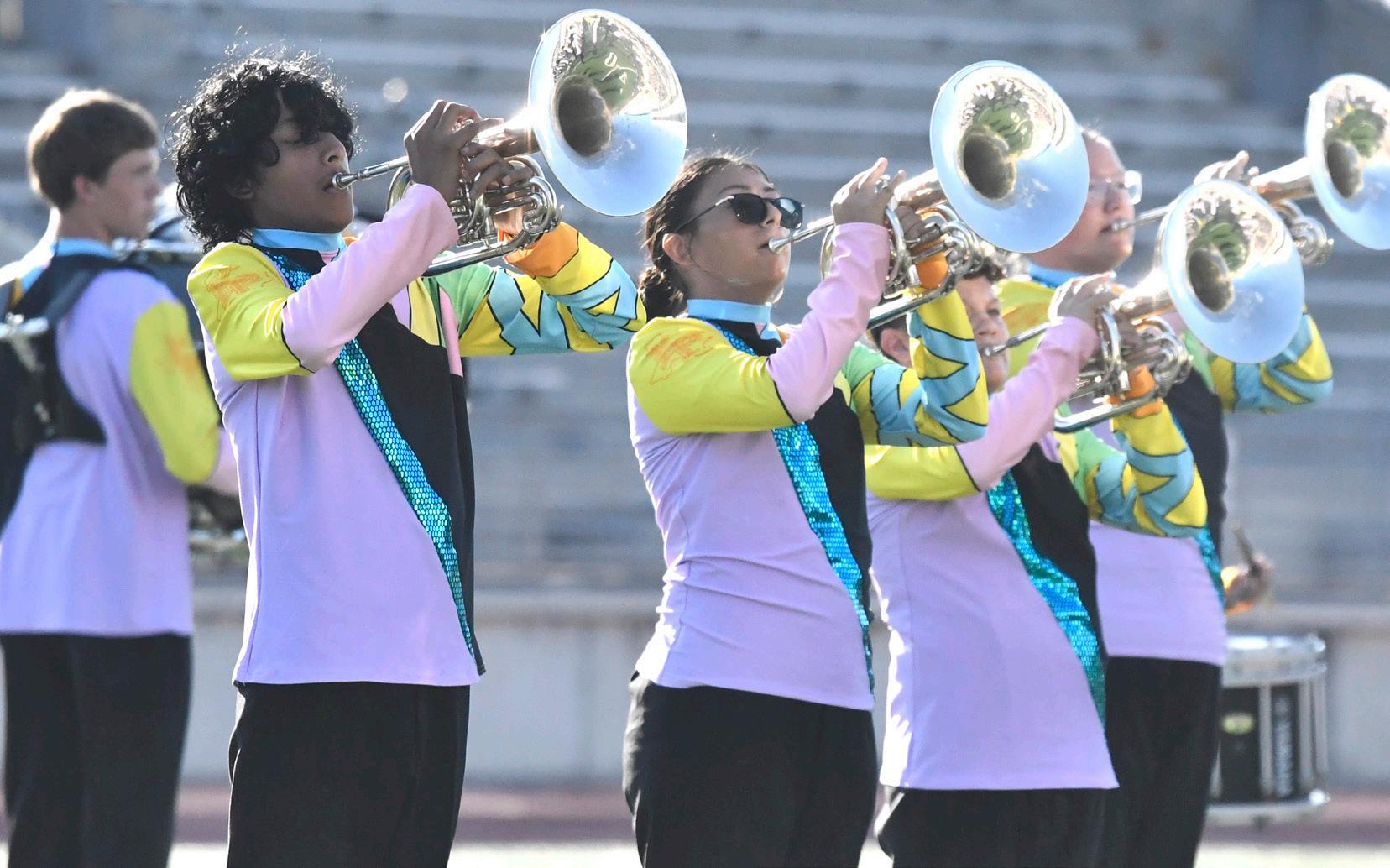


By Isabella Muñoz and Kalia Powledge Special Contributors
Band director Bre Osbourn wanted to have some fun with her students with the band theme. For months, she pranked them. She claimed they would dress up as mustard and ketchup for a sandwich-themed performance.
Drum major and senior Emma Vincent did not find dressing up as sandwiches funny.
“You’re lying,” she told Osbourn. “I’m not doing the show.”
Vincent was right; and eventually, Osbourn revealed the actual theme. The band would dress in Dr. Seuss-themed uniforms and use fun props for a show called “Oh, The Places You’ll Go!”
Over the summer, the band started working on the show and has put in countless hours finetuning it. The hard work paid off at the group’s first UIL competition on Oct. 18. The band made straight 1’s (the highest possible marks) and advanced to the Area competition.
“It’s tough to achieve that,” Osbourn said. “For our theme, ‘Oh, the Places You’ll Go,’ the band has these special uniforms and props. When

group of kids to come around and perform it. It is based on her favorite book. When she came to Kingwood Park four years ago, she met the exact group of kids she was waiting for.
“The seniors were freshmen my first year here,” Osbourn said. “They had never done shows like what we have done. And they were like, you want us to do what? And they’ve done it.”
They’ve done it well. Each of the last four years, the band has scored higher in UIL competitions than the year before – a streak Osbourn expects them to continue at this week’s Area competition in Channelview, where 46 teams will vie for the chance to compete at State.
you look at the field, it’s like looking at a page out of the book. And the judges made a lot of really awesome comments about how the band made it seem just like the book.”
In addition, three of the bands that competed in front of Kingwood Park had bigger props and various electronics on the field to boost their sound and add to their show.
“We don’t do that, and ours came out and got straight 1’s,” Osbourn said. “And actually we scored even cleaner and got higher scores than some of the schools that have all of those things to buffer for their stuff. So that’s a confidence building thing for sure.”
Osbourn had the show planned for 10 years, waiting for the right
After receiving feedback from judges and former colleagues, Osbourn said this is the band’s strongest show since she arrived in 2022. This year’s show will be a core memory for not only Osbourn but for all the seniors after high school, who have put in the hard work to get to this point.
“That’s the cool thing to see – that all the hard work paid off and you get to be excited about being rewarded for what you do,” Osbourn said. “That’s the fun part.”
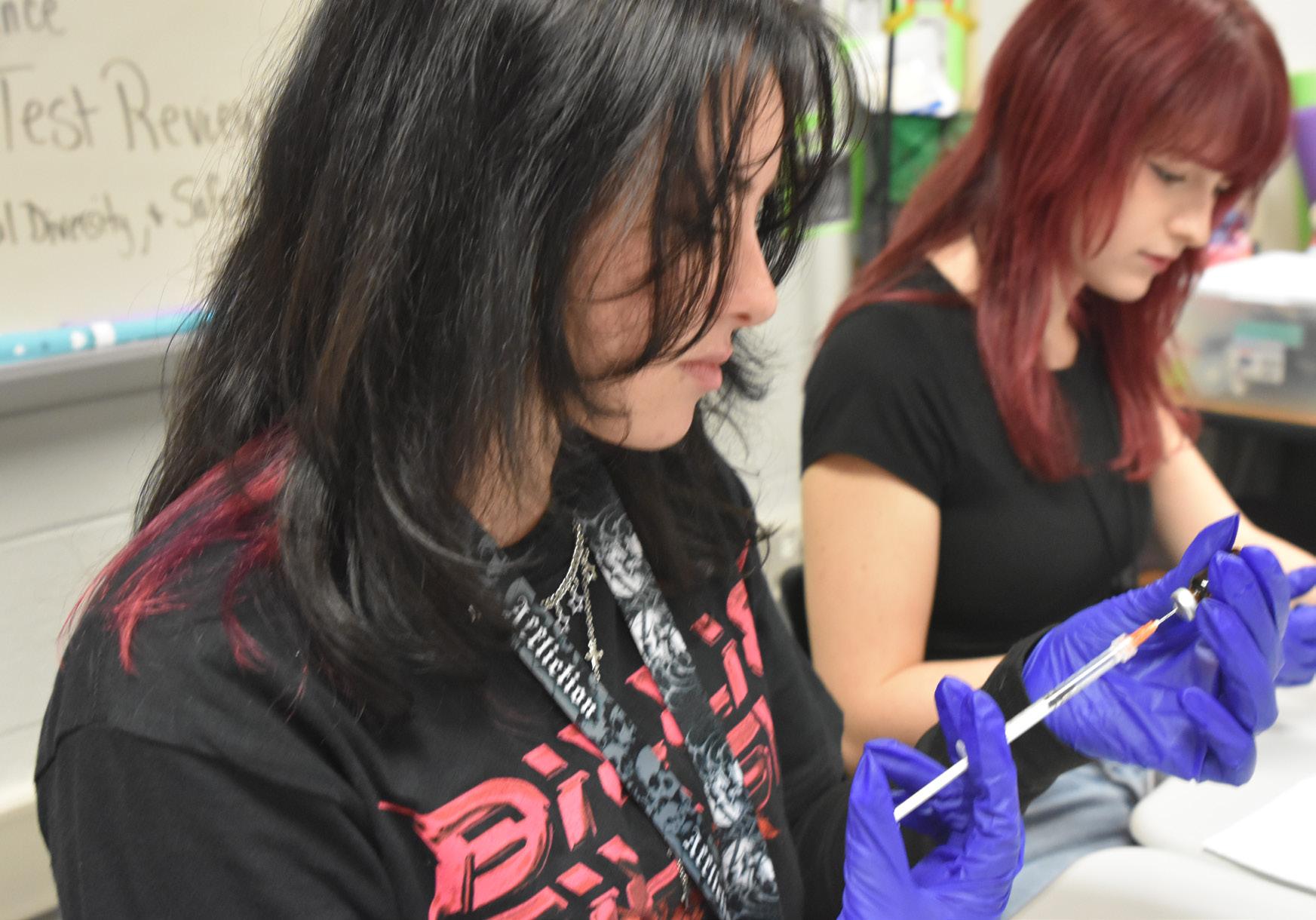
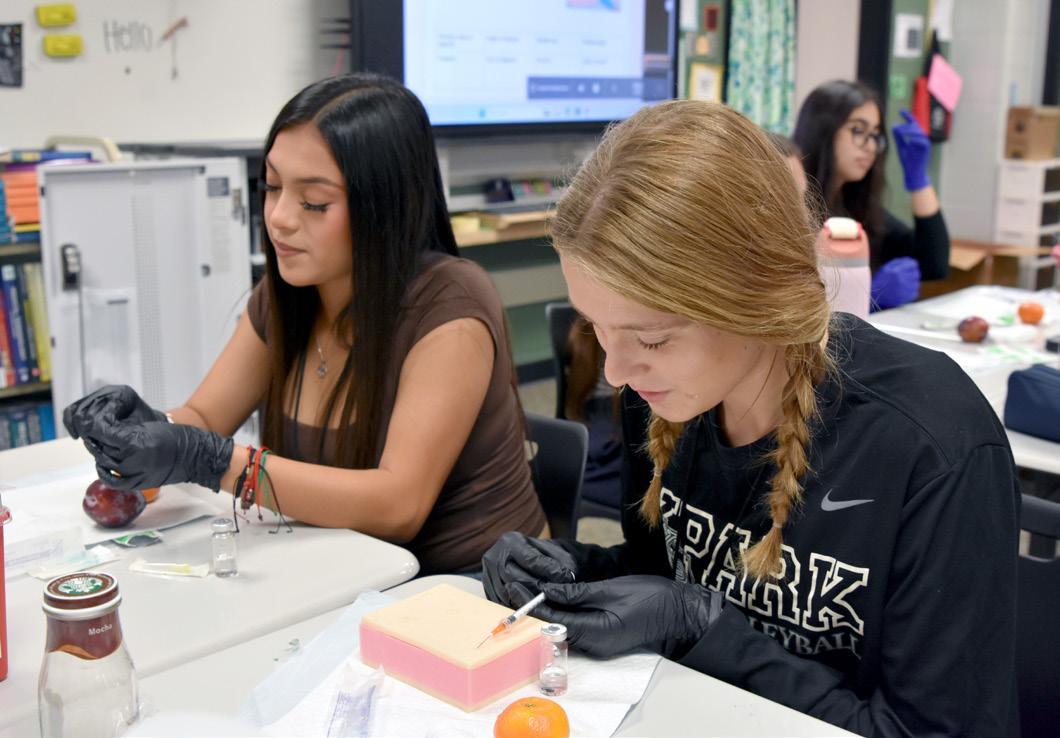

the various types of injections.
intramuscular
By Chloe Sales Staff Writer
With many people knowing what they want to be from a young age, Kingwood Park gives students the opportunity to start building their careers early on. From cosmetology to teaching, and even to healthcare, the school allows students to go off-campus to gain experience in their field of study. Interactive labs, off-campus shadowing, and in-class presentations are just a few of the ways that students in Health Practicum Theory prepare for their futures in healthcare.
Each one of the 19 students taking Health Practicum Theory go to their off-campus job sites every Wednesday and Thursday for approximately an hour and a half where they shadow and assist nurses to gain experience. At the beginning of the school year, students had to research nurses that they could shadow. All their sites needed to be different, and they needed reliable transportation to get to them.
Senior Anoush Clayton shadows
the school nurse at Creekwood Middle School, helping with various tasks.
“It’s mostly just vital signs. So, I take their blood pressure, I take their temperature, I take their pulse oximetry,” Clayton said. “I also just help them with whatever they need.”
Clayton says she wants to be an anesthetic nurse. She says she’s going to work in a hospital as a CMA while she pays for Lone Star so she can get her prerequisites. She then plans to transfer to a university. She’s been preparing for her medical career throughout all of high school, and Health Practicum has helped get her one step closer to her goals.
Senior Andres Campos is in Health Practicum Theory to help prepare for his career. He shadows at Kingwood Occupational and Physical Therapy and plans to go to college and get his undergraduate in exercise science and go to school for physical therapy.
“I observe the physical therapist and I ask questions, and sometimes I help them translate,” Campos says. “[I enjoy] getting some
new patients and observing their recovery process from injuries.”
All of the students’ work at their job sites helps them as they work toward their Medical Assistant Certification. Later in the year, they’ll take a written test that will encompass all they have learned this year.
Earlier this year, Health Practicum students participated in a lab to practice their injecting skills. It consisted of students injecting water from a syringe into various fruits and silicone injection pads.
The in-class labs help prepare students for jobs in nursing
“It was really good learning different types of vaccines and where you do them,” senior Tia Thompson says.
Health Practicum Theory doesn’t only help with gaining experience, it also gives students a boost when it comes to college. Students who are interested in nursing can add their certifications to their resume once they have the prerequisites to apply to nursing school. Students get extra points for having these certifications in their resumes, which can
increase their chances of getting in.
“I just had a student that graduated in 2024 call and say that she got into the Texas A&M nursing program.” Health Practicum teacher Leanna Rockwell said. “And I had a student that graduated in 2023 that last year, she called me, and told me that she got into the ultrasound program at Angelina College,”
Even if a student isn’t able to attend college, they can still be successful with the certifications gained in Kingwood Park’s CTE Health Science classes. Hospitals regularly hire patient care technicians, a job that requires certifications (Patient Care Technician and CPR) earned in class.
“So with those two certifications that they have, they can get a job at a hospital,” Rockwell said.
With all of the health classes Kingwood Park has to offer, students are getting hands-on experience, further preparing them for their futures in the medical field.
“It’s really fun seeing what you’re learning in class in person, in action,” said Thompson.




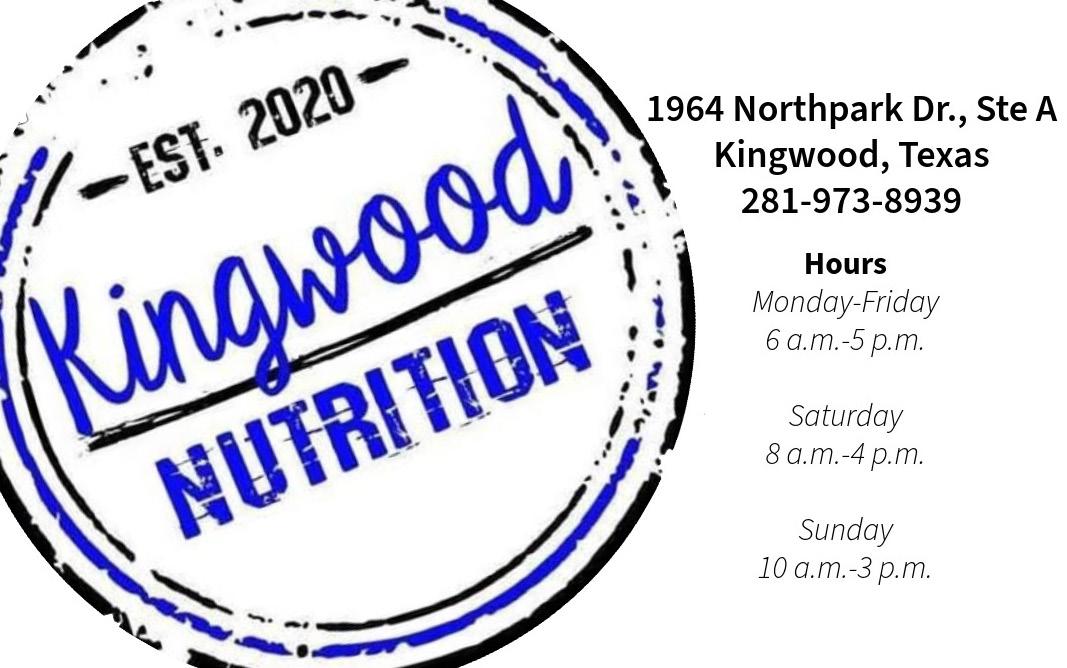
Compiled by Paisley Thomas
“They give a lot of energy, they help me sleep and they calm me down. They’re just really crisp and good. I would get Red Bulls every day with my mom before elementary school, and then we switched to Monsters, then we switched back to Red Bulls, and then to Celsius, and now we’re on Blooms. I drink them for the flavor and for the bubbles.”
Hunter Harmon, 10
“I love the caffeine rush you get when you start drinking them. I started drinking them when I was 8; and if I don’t have one it makes me tired and moody, and I don’t really want to be at school. My favorite brand is Celsius, and I drink them two to three times a day.”
Jackson Fogleman, 10
“I like them because they give me energy. Occasionally my students say it’s unhealthy, but my response is, I’m not a coffee drinker so that’s why. That’s my caffeine kick. If I don’t have an energy drink, I’m just dragging all day. My favorite brand is Celsius.”
Darnell Woods, ASL teacher
“They taste good and calm me down. If I don’t have one, I just feel kind of crazy and tired. My favorite flavor is the original Monster flavor. Back in middle school, my mom didn’t let me have Monster. She said it was going to kill me. Of course, I said ‘Yes ma’am,’ and went back to my room, and I never had one for like four years. Then one day she offered me one, gave it to me, and my life has been awesome ever since.”
Cadence McMahon, 12

“They keep me energized when I’m tired. I just go to Speedy Stop and grab a Red Bull. I started drinking them around two years ago. I drink them twice a week.”
Jude Richard, 12
“I love them because they give me energy. I have people telling me, ‘Oh, you shouldn’t drink it, you’ll have a heart attack,’ but it hasn’t happened yet. My favorite flavor and brand is Monster, the grape one. It affects my day positively. It’ll wake me up if I’m ever sleepy. If I don’t have one, I’ll probably fall asleep in class.”
Adrian Gutierrez, 12
“I like the packaging, it’s really whimsical and they make me more hyper than I already am, so I like that. I started drinking them when I was in eighth grade. When I have tests and I need to focus all day, they help with that. It doesn’t badly affect my day if I’m off an energy drink; I’m just less hyper than I usually am. My favorite brands are Alani or the V8 energy drinks because they have less caffeine and don’t make me jittery. I drink them two or three times a week, but I don’t like having them every day because it’s kind of bad for you.”
Brooke Burns, 10
“I like when it gives you a little mini heart attack. I started drinking them in sixth grade. I find it easier to move throughout the day depending on what energy drink it is. I feel less anxious when I have one. My favorite brand is Monster, and I drink them like two times a week.”
Marley Russell, 11
Ghost - 16 ounces
200mg of caffeine
5 calories
0 grams of sugar
Celsius - 12 ounces
200mg of caffeine
10 calories
0 grams of sugar
Alani Nu - 12 ounces
200mg of caffeine
15 calories 0 grams of sugar
Monster - 16 ounces
160mg of caffeine
230 calories
54 grams of sugar
Bang - 16 ounces
300mg of caffeine 0 calories
0 grams of sugar
Bloom - 12 ounces
180mg of caffeine
10 calories
0 grams of sugar
By the numbers
A
ccording to the Food and energy drinks have between caffeine in 12-fluid-ounces. only having 400mg of caffeine energy drinks have half the 12-ounce can. Learn more your favorite energy drink. Pilar Retamales.
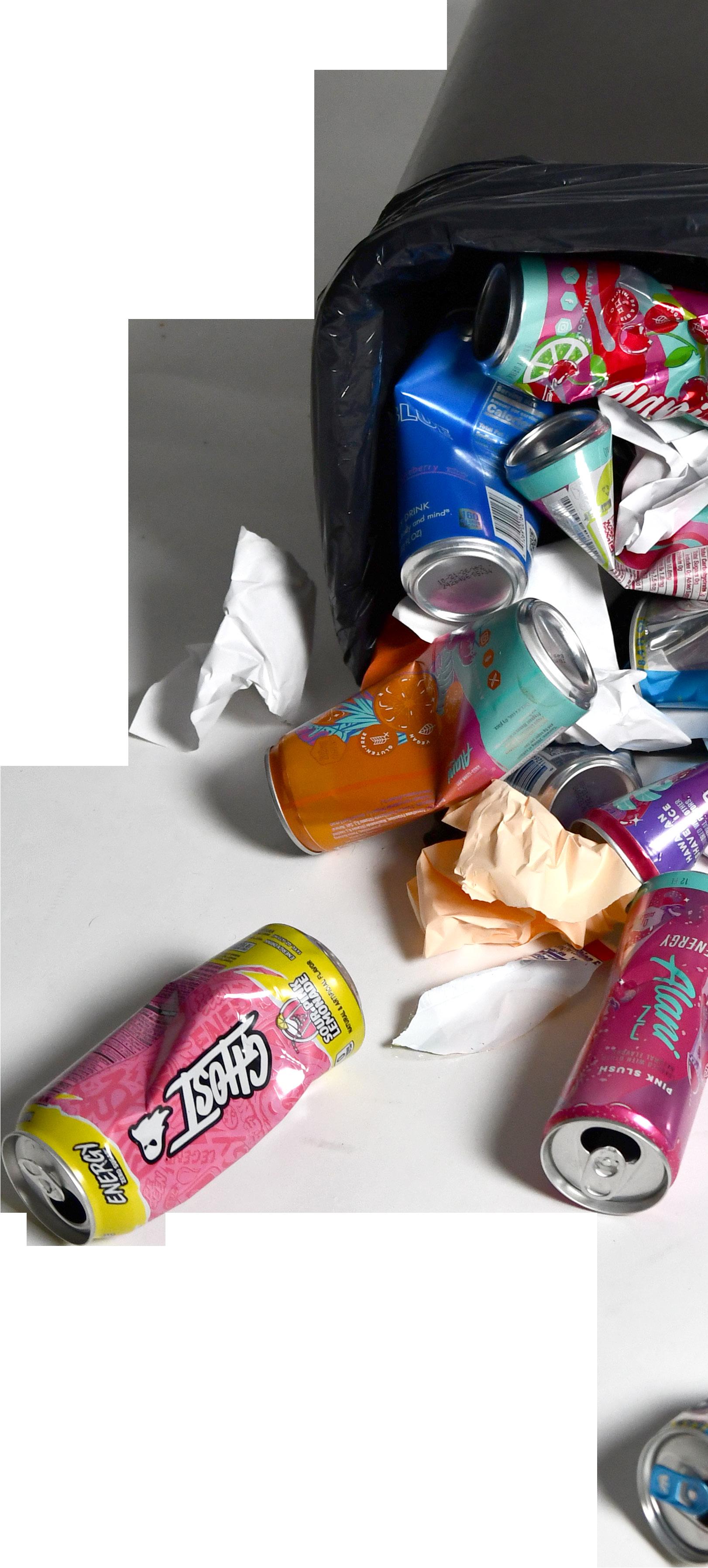
numbers and Drug Association, (FDA) between 41mg to 246mg of
The FDA also recommends caffeine in the average adult. Some the recommend amount in one about the amount of caffeine in
Compiled by Tricia Darcy and
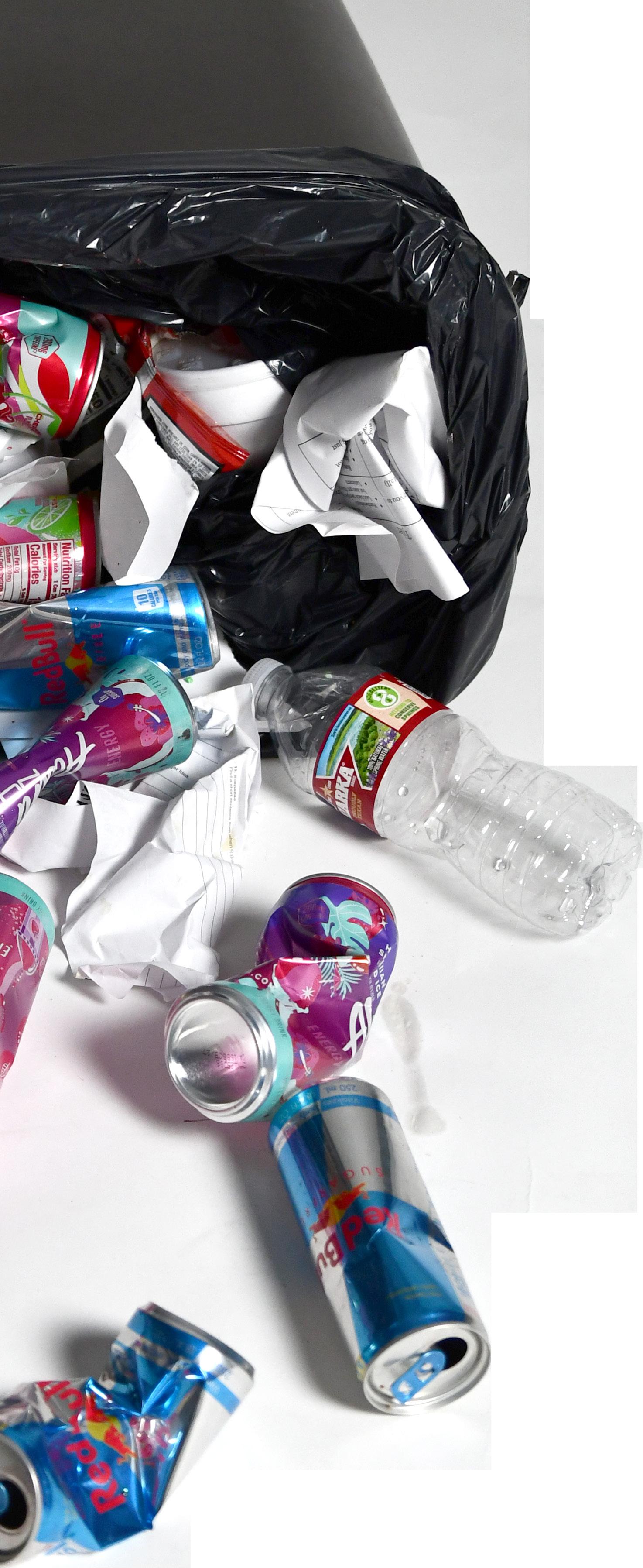
Compiled by Genesis Murillo and Sydney Ortiz
“I don’t like energy drinks just due to the amount of caffeine that’s in them. I think it’s really bad for your overall health and your heart. I also think there’s better alternatives for energy. I think it just ruins your health in a way. It just overrides your heart pretty much and it gives you like a significant amount of caffeine.”
Conner Copeland, 12
“I just think they’re bad for your health. I’ve never drank one. I was born caffeinated. There’s a lot of sugar usually. There’s no safe products and it has caffeine. I just don’t drink caffeine.”
Noah Laughlin, 12
“I feel like they just mess with people; and, for me, it makes me way too energized. I used to drink them daily. But you can get energy from like eating and exercising.”
Colin Simpson, 10
“I don’t like energy drinks because they really mess with your health and it can mess with your mental health as well. I think it weakens your heart. I usually eat sugar or I like just get a good night of sleep. That’s how I get my energy and eat good.”
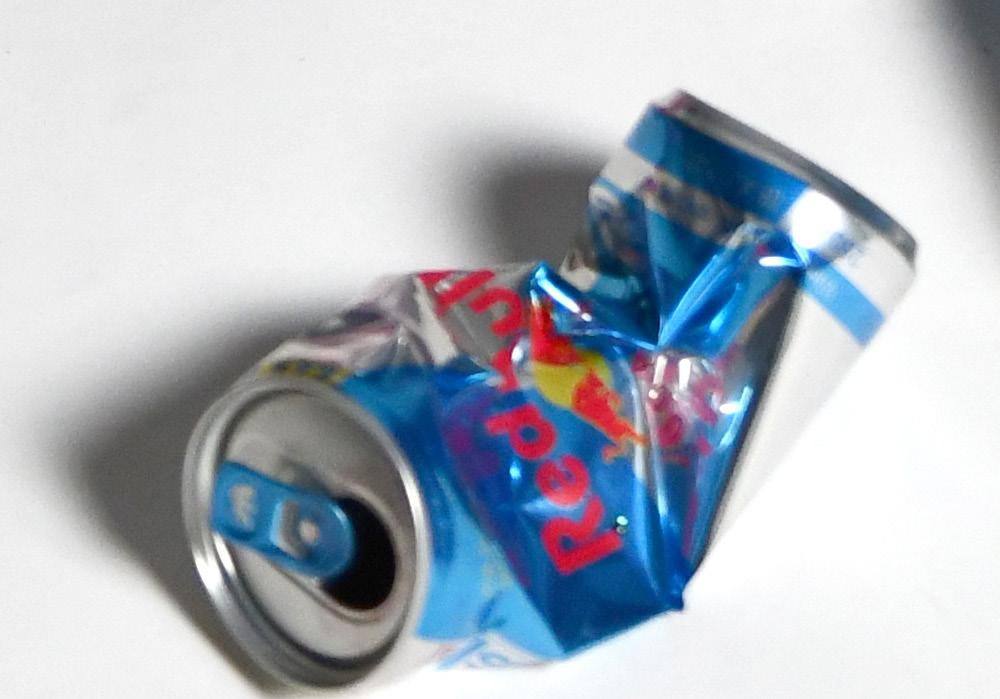
Isabella Salgado, 11
“They just suck. They are the devil’s
Cole Anderson, 11
“It’s mostly a me thing. Each time I drink them, they give me a bad headache and they make my entire body ache. I think having one, like if you’re tired, but I know people who drink them like twice a day. And so I think that like everything else does have a negative effect on your health.”
Ethan Durand, 12
“I don’t like them. They are highly addictive, and they set the path straight into trying bad things. Energy drinks pave the way into addictive behaviors.”
Kylie Tellez, 9
“I just think it makes you too energized. You just overstimulate when you drink it. I don’t think you need it. Some people like feed off it. I don’t think it’s a requirement basically.”
King Perry, 11
“They’re bad and unhealthy and promote bad habits. It makes you more dependent on caffeine than your own self and are a waste money.”
Jeremiah Head, 11
“They’re too bitter or sweet. They’re just not good. They have it at my work a lot, and I got sick of them after a while. I drink coffee twice a day. So I drink it in the morning when I wake up and then at like 3:30 or 4 when I get home.”
Kaely Evans, 12


Love ‘em or hate ‘em, energy drinks are only growing in popularity.
By Marie Wakefield Staff Writer
Junior Allie Minick starts the day like millions of other American teenagers with a crisp, carbonated, caffeinated, chemically created energy drink. She usually stops at SpeedyStop or Walmart on her way to school to get a Strawberry Guava or Grape flavored Reign drink. To her, it’s a necessary step in her morning routine that keeps her awake and alert for a full day of school and sports.
The routine is much the same during the softball season for the pitcher. A tradition among her softball team involves stopping at a gas station together to purchase pregame energy drinks.
“Usually I ‘shotgun’ at least one because it gets the heart pumping and the blood flowing,” Minick said.
The energy drink market, which boasted a net worth
of $80 billion in 2024, relies heavily on teenage consumption. According to the CDC, one-third of all adolescents in the United States regularly consume them. Common brands enjoyed by teens include Alani, Monster, Red Bull and Bloom.
However, not everyone at Kingwood Park sees the popularity of energy drinks as a positive. School nurse Mary Fischer, who has worked as a healthcare provider for more than 30 years, is one such objector. Her main concerns are the harmful effects that the high sugar and caffeine present in energy drinks have on the heart and kidneys. This is especially problematic, she said, when dealing with developing adolescents. While the recommended caffeine intake of an adult is around 400mg, the Ameri-
can Academy of Pediatrics does not recommend any consumption of caffeine for adolescents. The typical energy drink has between 80 and 300mg of caffeine. Fischer says that she sees students with caffeine related ailments in the school’s clinic daily.
“Someone comes in with some symptoms and they’ll have a headache, or they’ll feel shaky,” Fischer said. “And when we go through the things they did that day, you’ll find out that they had an energy drink or they went through Starbucks and got three shots of the espresso. It’s the sugar crash plus the caffeine.”
While Fischer understands the appeal of energy drinks to students who are faced with external pressures such as homework, sports and socialization, she still cautions that the risks outweigh any benefits. While the long-term
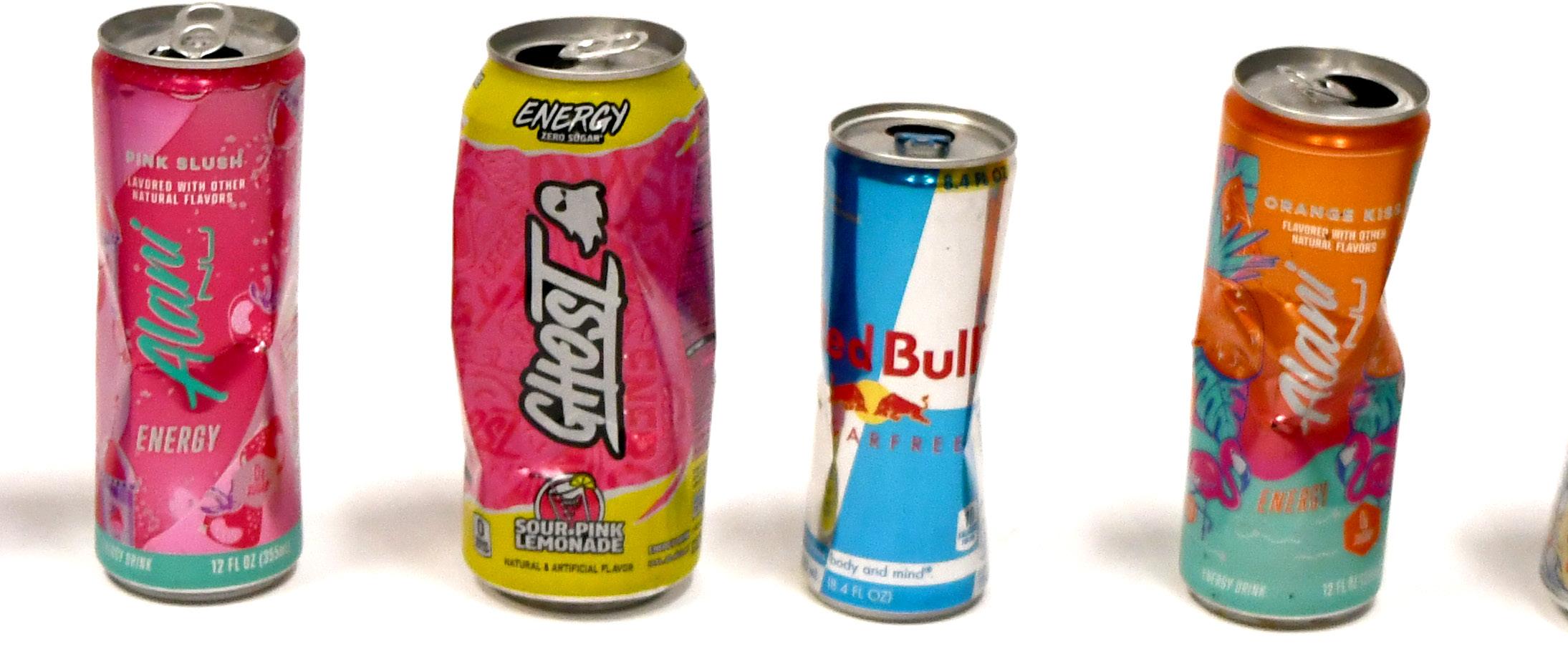
effects of energy drinks have not been fully determined, some studies say that longterm consumption of energy drinks can lead to increased risk of cardiac issues.
Fischer has noticed in recent years that students have switched from Red Bulls and Monsters to what are perceived as healthier or cleaner options, like Bloom. Fischer warns that these are still not ideal because of the artificial components present, some of which have been linked to diabetes.
“If you went to your pediatrician, they would still tell you you should not be drinking those,” Fischer said. “Even though they may not [have] sugar, there’s still an alternative sweetener in there.
department, only Gatorade and water are provided at football and golf events. Volleyball does not allow athletes to have energy drinks on the court or sidelines, and in girls track and cross country, they are not allowed anywhere.
“I have a very strict ‘no energy drink rule’ when it comes to anybody in cross country or track,” coach Cody Cook said. “I am as anti-energy drink as you can get.”
“ “ You’re growing up, everything is still adjusting. Everything is still maturing. The last thing you need to be doing is putting an artificial heart attack in your body while you’re growing up, especially as an athlete.
nurse Mary Fischer
And those usually are chemical based manmade stuff that aren’t healthy for you.”
Fischer is not the only faculty member who objects to the consumption of energy drinks. In the athletic
Cook implemented the ban after he started coaching girls cross country. He bases his policy on past experiences and personal research he’s done in an effort to find optimal performance strategies for his athletes.
“You’re growing up, everything is still adjusting,” Cook said.
”Everything is still maturing. The last thing you need to be doing is putting an artificial heart attack in your body while you’re growing,

especially as an athlete.”
Others in the faculty find that for personal use, however, the drinks can be a good way to keep energy up throughout the day. Coalgebra teacher Marty Purcell finds that an Aspire is a healthy way to keep going during her days, which typically start at 6 a.m.
“Around 9:30 or 10 a.m. is when I’m going to have my Aspire and it just kind of gives me that little extra,” Purcell said. “My eyes feel more open. I just feel less fog in the head, just more awake.”
One of Purcell’s focuses is making sure the ingredients in her drink are healthy and in moderation. Aspire in particular boasts plant based rather than synthetic caffeine and more natural ingredients than other brands.
“I only want to have one a day because it’s 80 milligrams of caffeine,” Purcell said. “One time I tried the Alani and it was like double that caffeine, and I could tell the difference.”
Student organizations have recognized the popularity of energy drinks, including the Student Council’s sale of Alani energy drinks at this year’s Senior Sunrise event.
They provided the caffeinated drinks in three flavors, all of which sold out at the event.
“We were looking for an opportunity to have a quick and easy fundraiser that was different from the usual spirit nights,” 2027 Class President Abbie Miller said. “We saw [energy drink sales] as an opportunity because most students are really tired in the morning and Senior Sunrise started at like 6:15, 6:30 a.m. So, we got there early and took advantage of the demand for energy drinks. Then that maximized our profit.”
Energy drinks show no signs of fading in popularity amongst teenagers. The energy drink market is expected to grow eight percent by 2030 and reach a cumulative net worth of $125 billion, according to a study by Grand View Research. And while some countries like England have recently banned the sale of energy drinks to minors under 16, the U.S. has made no such overtures.
“I’ve heard they can cause heart attacks, blood clots, and a bunch of other things that are really bad for you,” Minick said. “But I’m thinking, if I’m gonna die from an energy drink, then why should it even be sold in the first place?”

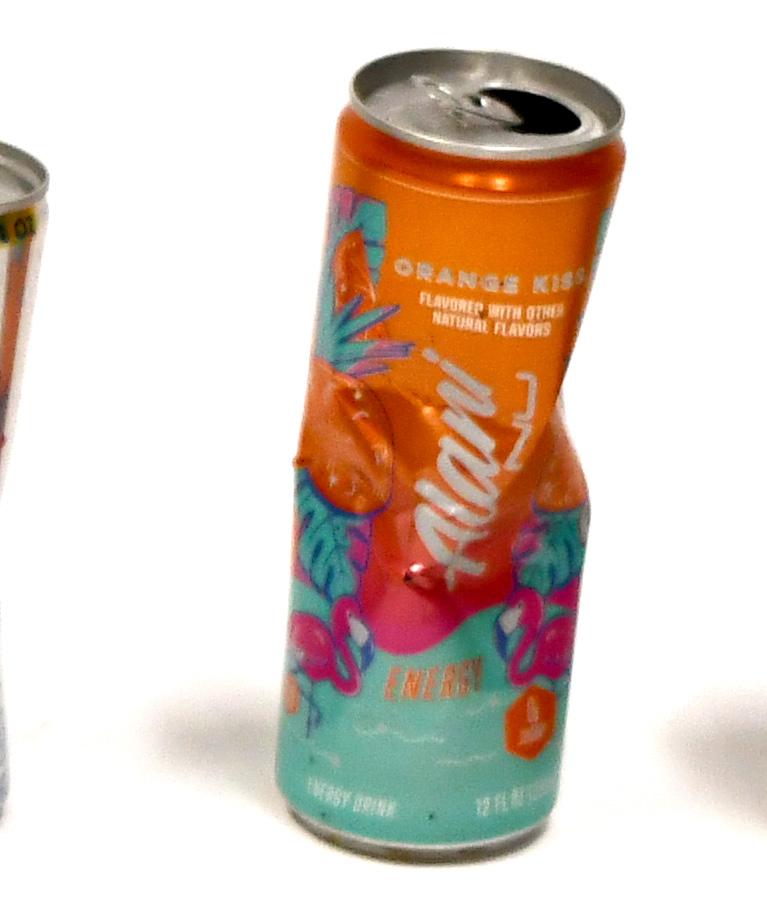

By Sydney Ortiz Editor-in-Chief
Ayear ago, Dane Solomon was playing safety when he got caught up in a pile of players after a tackle against Crosby. The pain in the right knee set in immediately after the play, but the panic was delayed.
Initially, Dane said the athletic trainers told him he likely suffered a hamstring injury and he’d need a week or two to recover.
But after the pain continued for four days, they recommended Dane get an MRI done.
“When we found out that it was a torn ACL, he literally cried,” said his father Wes Solomon, who is the principal at Kingwood Park. “He cried for two reasons: one, football, but he was really upset that he wasn’t going to get to play basketball either.”
For Dane, his dad’s calmness helped him get through the toughest days of his injury.
“He kind of kept my head on straight,” Dane said. “He told me it’s gonna be a long journey, but like you gotta get through it.”
That first month was a struggle for both father and son. For the first time in years, Dane was coming home every day after school instead of heading to a game or practice.
“Being isolated, being away from his team, being away from doing things that he loved, as a dad it killed me watching him go through that,” the elder Solomon said.
Last Nov. 21, almost a

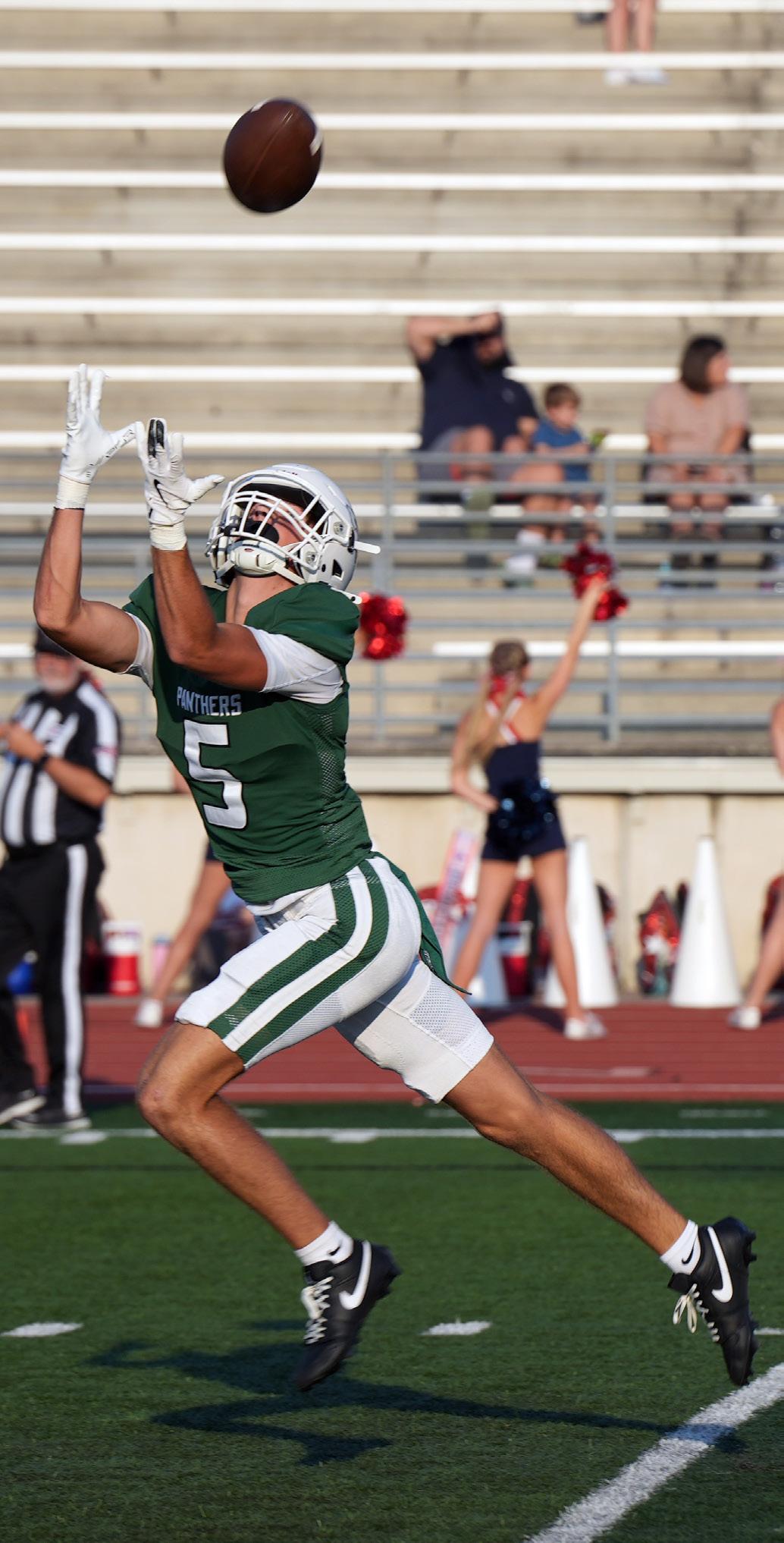
month after tearing his ACL, Dane had surgery. Almost immediately, his motivation returned and he was determined to get healthy so he could play the sports he loved.
From November until late July, Dane went through rehab two or three days a week.
“The rehab process was phenomenal but also grueling,” Wes Solomon said.
Dane missed his entire

After senior Dane Solomon scored the first touchdown of the game against Clear Lake, Solomon and senior Bryce Gerbasich celebrate in the end zone.
Senior Dane Solomon catches a pass from sophomore quarterback Jon Pavlatos for the first touchdown of the game. The team won 50-47 against Clear Lake. Photos by Tricia Darcy.
junior basketball season and the spring seven-onseven football.
At the end of July, he was cleared to return to sports.
“It was a little bit nervewracking,” Dane said. “But I kind of am not really scared of getting hurt. Injuries happen.”
Dane was just happy to be back on the field, and so were his coaches. In the season opener, he caught four catches and scored a
touchdown.
“The biggest moment for me was just seeing him come back and have such a huge game his first game after a serious injury,” wide receivers coach David Feliciano said.
Dane has made the most of his opportunities. He leads the team in receptions, yards and touchdowns. But his contributions are not all seen on the stat line.
“He’s first and foremost a tremendous leader,” football coach Clayton Maple said of Dane. “What he does off the field in the locker room as a leader is just indescribable, and I’m so appreciative of that. Then on the field, obviously he just leads by example with the way he practices, the way he works, the way he is there for other players.”
As the one year mark approaches for when Solomon had surgery, the senior who plans to attend Texas A&M to major in construction science said he has definitely changed. In the eight months without sports, Dane put his energy toward being a key member of the architecture’s Tiny Home program as well as a job as a car washer at Shiner’s.
“I always thought that I was just a football player, a basketball player, but I noticed that I had more of an identity other than just sports,” Solomon said. And through it all, the love he had for sports never diminished. Solomon’s dad was proud as he watched his son fight to return to his teams.
“He went through all the trials and tribulations,” Wes Solomon said. “He’s back doing what he loves. … I was nervous that he would just say, ‘I’m not going to play football anymore. I’m not going to play basketball anymore because it’s just not worth it.’ He never said that. He just kept day by day getting better, better, better.”

By Kamryn Blanford Staff Writer
This year the expectations are high for the golf teams with experienced golfers returning for the girls and boys.
Sophomore Lilly Raymond returns to lead the girls a year after she reached the State Meet. On the boys side, two-time state qualifier Cory Case returns for his senior season. Coach Angela Chancellor expects more to join Case and Raymond as they work to return to the state’s biggest meet.
“We feel like we have some individuals that are capable of doing that on the boys and the girls side,” Chancellor said.
Senior Seth Ferguson returns as a key leader on the boys side with Case. Returning senior Max Raymond and sophomore Parker

McGehee will also provide crucial experience for the boys in both the District and Region tournament.
On the girls’ side, sophomores, Jamie and Gracie Ingalls join Raymond as leaders. Raymond, Jamie and Gracie all qualified for the Region tournament last year, and have hopes to make a return.
The golfers look to each other to help with team morale on the course. Jamie Ingalls said Case and Raymond are strong leaders.
“Cory just compliments everyone, even if they’re doing bad,” Jamie Ingalls said. “And Lilly because she has the most experience, but she’s also really sweet.”
Case has been playing golf since he was about 4. He loves to go to practice and motivate his teammates to try their best. His favorite player is Tommy Fleetwood.

Raymond has been playing since she was 9 years old. Her dad started playing in college and wanted his daughter to start playing earlier. Raymond said she likes that golf is an individual sport and that you have space to feel free.
“Having fun is the best way to keep a good mentality,” she said.


Red Bull. Celsius. Witches’ Brew. Alani. Ghost. Bloom. C4. Monster. Prime.
No, those words aren’t the code to activate a sleeper cell agent.
If you’re a teenager, there’s almost a 100% chance you know that these are popular energy drinks, and a 30-50% chance you actually drink them, according to the CDC.

Energy drinks are constantly handed to people on the silver platter of convenience. They’re everywhere. Gas Stations, Grocery stores, even some school cafeterias, because 75% of school districts don’t have a policy about them at all. They’re marketed specifically to the younger generation, with colorful cans emblazoned with even more colorful labels with even more colorful promises promising focus, energy and enhanced sports performance. To a high schooler, that seems like the panacea to all of their problems – AND they taste good? This must be heaven sent, right?
But, we must ask ourselves, good taste notwithstanding: Are energy drinks not the solution, but the issue?
We’ve looked at the front of the energy drink can; now let’s look at the back. I know, ‘tis a taboo and terrifying practice, but steel thyself, for it must be done.
On first glance, (or, perhaps, the second as the glaring neon colored sheen of can might momentarily burn one’s retinas) the immense proportions of added sugar are enough to dispel any notions of perceived benefit almost instantaneously. For example, if we took a look at the official ingredients for the Original Red Bull located directly from Red Bull’s website — which
conveniently only showcases 8.4 fl oz, the smallest size available— we would see the added sugar content is 26 grams. That is an astronomical number for a small drink, and already over what the American Heart Association recommends for teens in a day.
Lately, however, people have become more aware of the negative effects of sugar and have been seeking alternatives. However, another pressing issue is often hidden in the supposedly “healthier” options. Zero sugar energy drinks like an Alani Nu are exploding in popularity.
HALF of the caffeine to leave the body.
Let’s see how this works in a hypothetical. Billybob is a straight
A student athlete. After a late night studying for his chemistry test, he feels sluggish the next morning and he takes an energy drink at 8 a.m. Let’s say, it’s an Alani Nu because he’s an athlete and he wants to be healthy. The caffeine content is 200 mg.

“But Marie,” some disgruntled individual might persist, “I got rid of the evil sugar. I’m literally being healthy.”
Well, my benighted friend: yes, there’s no sugar. But that sweetness has to come from somewhere, and this often comes in the form of artificial sweeteners, which hold their own host of health risks. For example, other artificial sweetened drinks like diet soda have been found by the American Diabetes Association to increase risk for Type II Diabetes by 67%. (It’s not only tragic and preventable, it’s literally six-seven.)
Those are all definitive problems. However, they are not unique to energy drinks: high sugar and substitutes are embedded into the food industry. The true nail in the coffin for the case of energy drinks lies in the nefarious mountain of caffeine content.
Caffeine, in general, is perhaps
the worst thing besides smartphones to happen to already chronically sleep deprived children. The biggest thing that makes caffeine so harmful to developing humans is the disastrous effect on sleep. This deserves its own article, but teens need sleep, and a lot of it. According to Johns Hopkins Medicine, teens are supposed to get around nine hours of sleep.
Now, we all know for most teens, and all their commitments nowadays, nine hours is an impossible number. This makes any sleep at all even more valuable, and energy drinks ravage the paltry sleep teens can get.
To understand that, we need to understand the nature of caffeine. Once ingested, it takes about 15 minutes to be absorbed into the bloodstream. That’s the “buzz” people have become slaves to. Quick and easy energy right?
Well, that energy doesn’t just get you through your task and then leave you unscathed. It stays in there for a long time because of a chemical component called a half life. A caffeine half life in action means that it will take 3-7 hours for
That means that by 3 p.m., 100 milligrams of caffeine (the equivalent of a large cup of coffee) will still be in his system. Coffee drinkers will know that drinking caffeine after noon already spells a sleepless night, so by drinking one energy drink at 8 a.m., you’ve almost guaranteed yourself a night of poor sleep. Billybob will get up the next day and be tired. So what will he do to wake himself up?
Shotgun another energy drink. And so the cycle continues. The consequences of poor sleep? Sometimes fatal. Driving while drowsy can be as dangerous as driving while intoxicated, and is involved in up to 21% of fatal crashes. Poor sleep is also related to depression and anxiety. And to make the circle of energy drink’s final uselessness complete, poor sleep directly hurts learning and memory.
Energy drinks do not solve true problems. They put a smoke screen and gaslight your mind into thinking you’re alert when your body is screaming for rest. Energy drinks do not help your focus, help you “lock in,” help you perform better athletically or stay healthy. Instead, they lock you into a self-defeating cycle of dependency
against an addicting substance. It doesn’t benefit you. So, then, who does it benefit?
Having read in depth all of the harmful and potentially harmful components of the energy drinks, let’s take a look at the most important one to find our answer. The small, fine printed parentheses that say four crucial words.
Not recommended for children.
Not recommended for children is squished on the back in the smallest possible font.
Huge, multi-billion energy drink industries spend top dollar to get entire generations addicted, because what do they care about the individual? These companies do not exist to help people. They exist to make money against all other concerns, risks and harms.
Red Bull. Celsius. Witches’ Brew. Alani. Ghost. Bloom. C4. Monster. Prime.
All of those billion dollar corporations, they all want YOU, the consumer, a cog in their machine that doesn’t even care enough about the welfare of children to change their policies.
Will you let them?
Bad Bunny posted a reel revealing that he would be performing in the Super Bowl halftime show. I was really excited when I saw the post because he’s one of my favorite singers, and knowing he would be singing makes it a must-watch event. Also, Bad Bunny is a big artist. The fact that they chose him to perform in an NFL game is a big deal. For a Spanish-speaking performer to sing on that huge stage, it’s a big deal for him but even bigger for the whole Latin community.
By Genesis Murillo

Of course, not everyone agrees with him singing in the halftime show. People online are split on
November 2025
Volume 12, Issue 2 Kingwood, Texas 77339
EDITORS
Tricia Darcy & Sydney Ortiz, editors-in-chief Danielle Nalley, online editor Cameron Minatrea, sports editor Paisley Thomas, opinion editor
STAFF WRITERS, PHOTOGRAPHERS & SPECIAL CONTRIBUTORS
Muhammad Adnan, Kamryn Blanford, Chase Canlas, Shawn Chaney, Jack Coffey, Charlie Crass, Rayden DeSouza, Jacob Dinh, Eleanor Durand, Rocco Huerta, Caleb Kazeem, Marien Martinez, Michael McElmurray, Isabella Muñoz, Marco Plascencia Carmona, Kalia Powledge, Pilar Retamales, Chloe Sales, Ja’Kayla Scott, Fabiain Smith, Marie Wakefield.
Adviser: Megan Ortiz
Cover: Photo by Tricia Darcy.
the topic. Some say he’s “not American enough” or that his songs are “too explicit.” Others say that “Puerto Rico isn’t American,” even though Puerto Ricans are American citizens since Puerto Rico is a U.S. territory. With this announcement for the halftime show, it reflects the fact people in American just don’t like change or the fact that the U.S. is more diverse now. In recent studies, Hispanics/Latinos make up about 20 percent of the U.S. population – the nation’s second-largest racial or ethnic group after non-Hispanic whites. A lot of people don’t realize how big of a deal this is for the Latin community, especially
during a time of turmoil in this country for Latinos. The Super Bowl is watched by millions of people around the world, and he’s representing the Latino community and sending an important message.
Whether you understand his music or not, you can still feel the passion in his music. His performance style speaks for itself.
At the end of the day, it seems like the NFL is trying to bring us together in a way, and I think they chose Bad Bunny for just that. Not only because he’s just a big hit at the moment but because of who he is. I think that this halftime show will be something to remember and not just because the performance will be outstanding, but because of what it stands for.
KP Media is the official student-produced media of news and information published/produced by KP Media students. KP Media has been established as designated public forums for student editors to inform and educate their readers as well as for the discussion of issues of concern to their audience. It will not be reviewed or restrained by school officials prior to publication or distribution. Advisers may – and should –coach and discuss content during the writing process. Because school officials do not engage in prior review, and the content of KP Media is determined by and reflects only the views of the student staff and not school officials or the school itself, its student editorial board and responsible student staff members assume complete legal and financial liability for the content of the publication.
The media will serve the best interest of the students and faculty of Kingwood Park High School, keeping itself free from any commercial obligations distracting from this purpose; this is defined by the media itself.
All writing in the media, other than letters to the editor in the newsmagazine, will be written by students of the journalism program and will not be accepted otherwise.
The media will specialize in and emphasize on informing their readers of school news and unique students of the Kingwood Park High School community.
The media will cover community, state, national, and international news if it is directly relevant to the school community, and includes local angles.
The media will strive to provide coverage to all school organizations and functions.
Any decisions affecting the publications on all levels will be made by the editorial board, the adviser is allowed to give legal advice and his/her opinion, but the final decision rests in the hands of the editorial board.
Only the editorial board may prevent material it judges to be in violation of the media editorial policy, from being printed.
Letters to editor will be printed in the opinion section of the newspaper or on the website. Letters to editor should not exceed 300 words, must be signed and must include writer’s address and phone number for verification. Letters to the editor will be verified by a member of the editorial board to determine the authenticity of the writer.
The school newspaper will be distributed free of charge to all students every 6-8 weeks. The paper is completely financed by advertising revenues and fundraising. The money raised is used to pay for the school media printing costs, supplies and other media expenses.
See the entire staff editorial policy at KPTimes.com
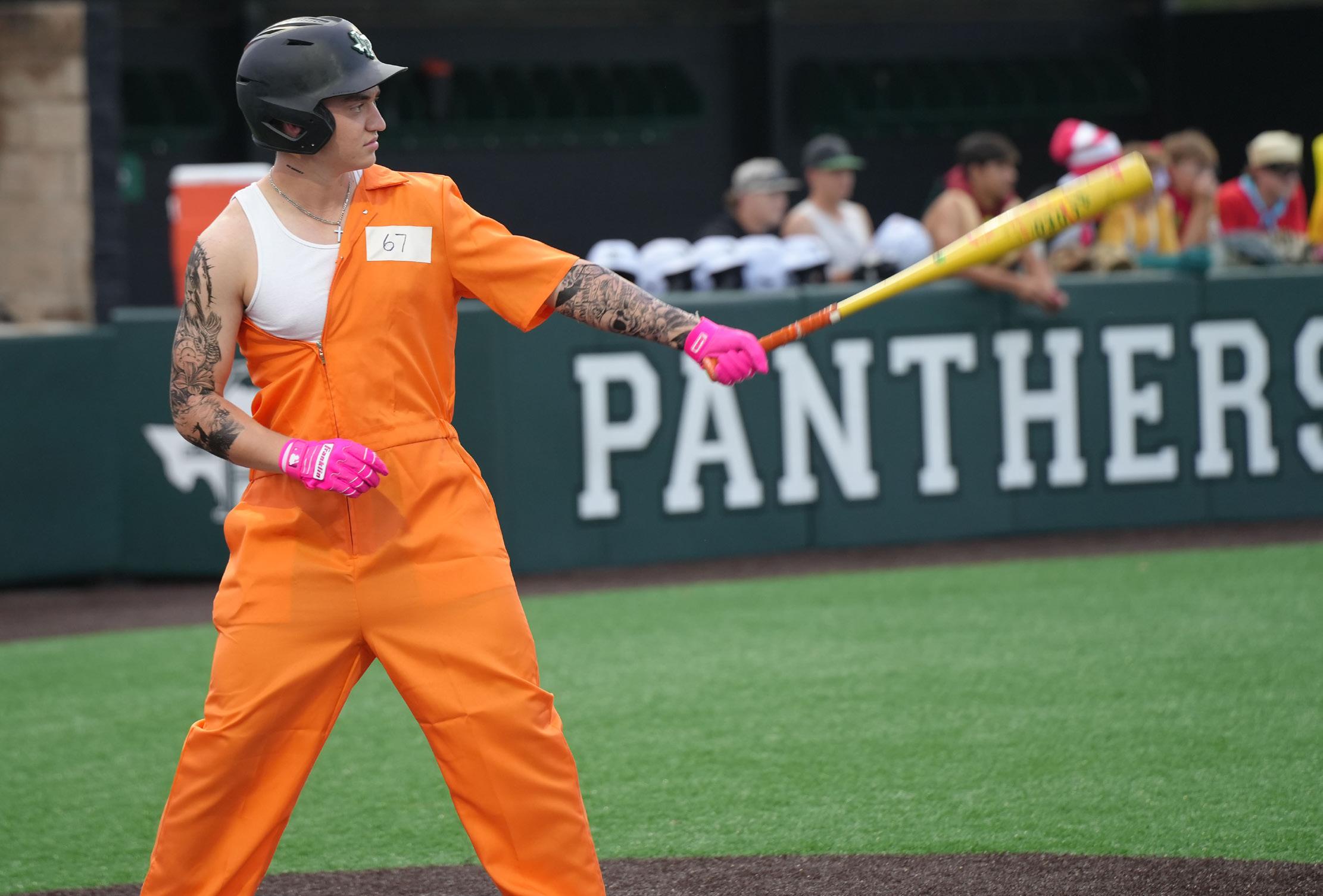
To make the Halloween season a little more fun, clubs and organizations got creative. The baseball team held its annual Halloween scrimmage with the players all dressed up in costumes on Oct. 28. In addition, Trunk or Treat was held on Nov. 1 in the parking lot with students getting to interact and entertain visitors at their themed cars.




